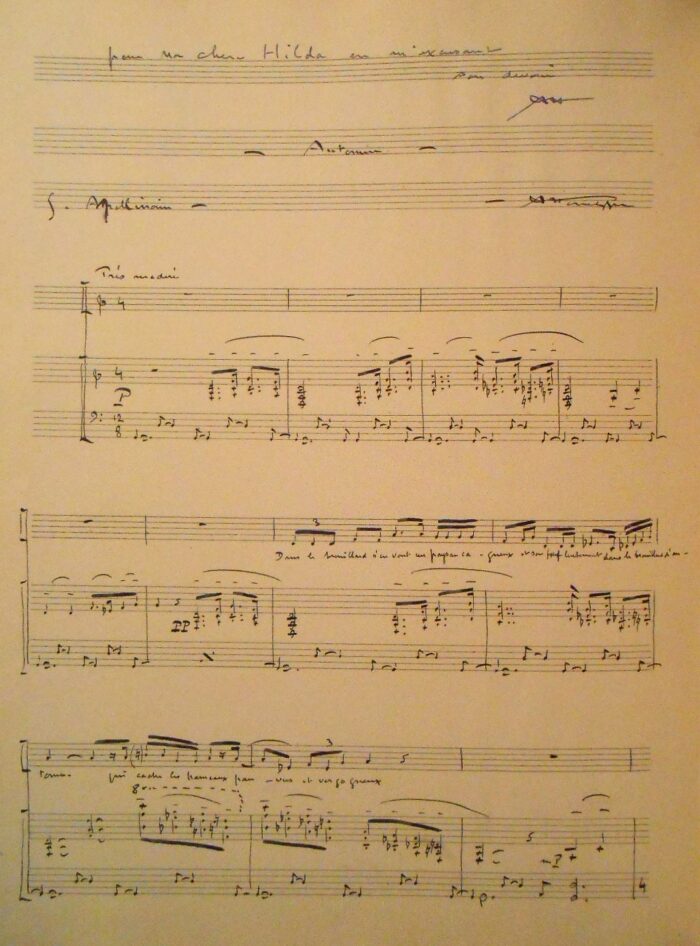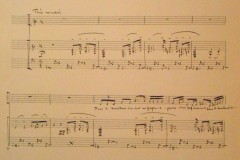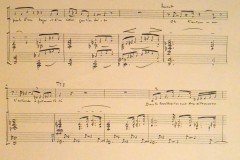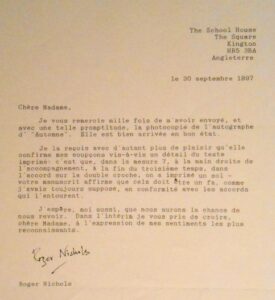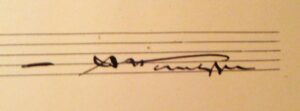Arthur Honegger (1892-1955). Automne. Autograph musical manuscript signed, Zurich, August 1915. Notated in black ink on 2 folio pages with 12 lines. Handwritten title in blue ink, in another hand, on a white endpaper. : « Arthur Honegger / Automne / Poème de Guillaume Apollinaire ». Rust-coloured Bradel-style boards, long title page in rust-coloured morocco.
The cycle of Six Poèmes de Guillaume Apollinaire (H. 12), taken from the collection Alcools published in 1913, was composed between 1915 and 1917. Chronologically, Automne, No. 3 in the collection published by Salabert, was the first of the six melodies, composed during the summer of 1915 spent in Zurich between two periods of military service; it was premiered on 11 July 1916 by Rose Armandie at the Salle Œdenkoven in Paris. Marcel Delannoy felt that the composer “would not often find the atmosphere of Automne, with such simple means”. Honegger himself declared in 1925, in Dissonances : “Automne […] satisfies my need for geometry as well as my need for emotion: I have seen what I am saying, I was Apollinaire’s peasant with gimpy legs at the time when, without glory, if not without boredom, I was doing my military service in Switzerland”. José Bruyr comments on “this cry, which is perhaps the first exact relationship between sound and its soul”: “the painting is admirably drawn, with beautiful muted, thick, ochre and grey colours.[…] In twenty bars, a masterpiece – his first – which, all in all, will have no analogue in his work”. Harry Halbreich also wrote of Automne, “his first and brilliant contact with the poetry of Guillaume Apollinaire”, that it is “a masterpiece indeed, and so Debussian still, this bewitching reverie with its modal and syncopated sway”; finally, Pierre Meylan added that Automne develops a melancholic melody whose “despair grips the heart“.
Tappolet, Arthur Honegger, La Baconnière, 1957, p. 22 ; J. Bruyr, Honegger et son œuvre, Buchet/Chastel, 1947, pp. 32-33 ; Harry Halbreich, Arthur Honegger, pp. 37, 347, 352-353 et 730 ; P. Meylan, Honegger, L’Âge d’Homme, 1982, p. 22 ; G. K. Spratt, The music of Arthur Honegger, n° 7, iii du catalogue, and op. cited p. 9.
With an hand-written sent from the composer in blue ink : « pour ma chère Hilda en m’excusant / son dévoué / AH ». Hilda Gélis-Didot (1890-1952) was a close friend of the composer and godmother to his daughter Pascale.
With an interesting typed letter signed by the musicologist Roger Nichols (b. 1939), dated Kington, England, 30 September 1997, addressed to the owner of the manuscript.1 page in-4°.
The manuscript does reveal a printing error.
Nichols warmly thanks his correspondent for promptly sending him a photocopy of Automne‘s autograph. “I receive it with all the more pleasure because it confirms my suspicions regarding a detail in the printed text: it is that, in bar 7, in the right hand of the accompaniment, at the end of the third beat, in the chord on the sixteenth note, a G has been printed – your manuscript states that this must be an F, as I had always assumed, in accordance with the surrounding chords […].”
Roger Nichols is the author of a documentary devoted to the composer and the translator of Harry Halbreich’s study of Arthur Honegger (Hong Kong, Amadeus Press, 1999).
Sold
